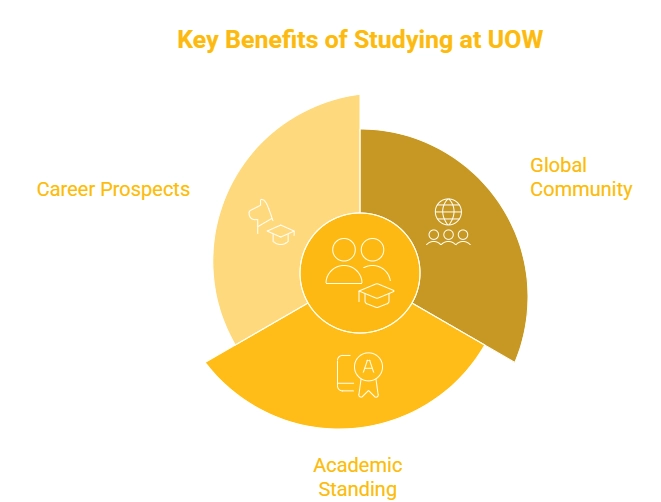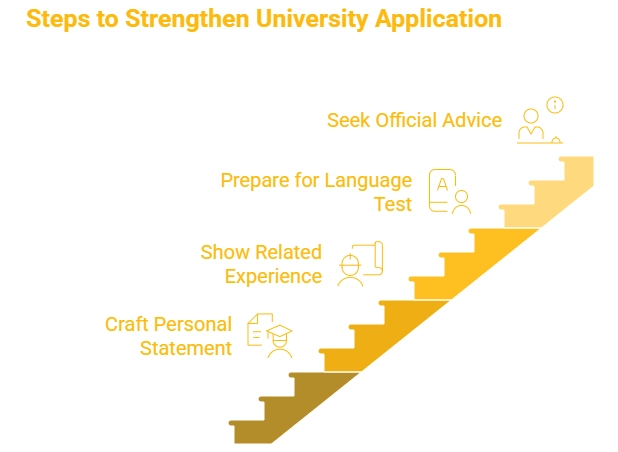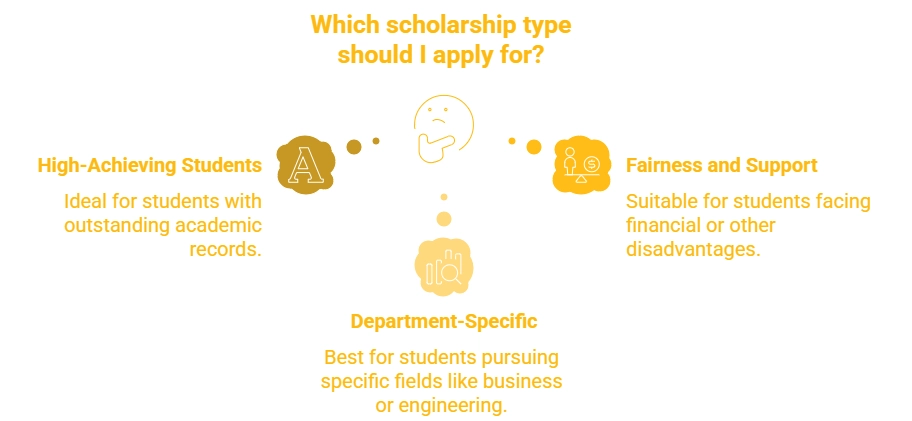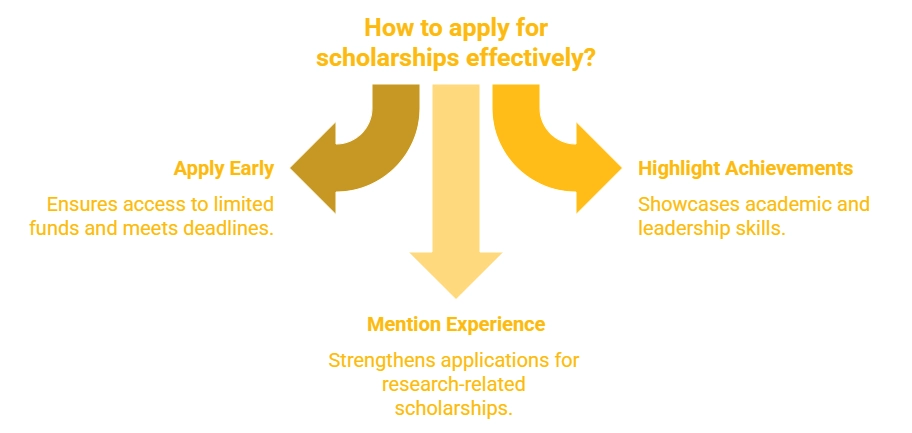When picking a university, consider the big picture. Here's what the data says about UOW:
*Need assistance to study in Australia? Y-Axis is here to assist you in all the ways.

UOW is well-regarded in global university rankings, often appearing in the top 200 in QS lists. The latest QS World University Ranking puts UOW in the top 200 worldwide, which shows its strengths in research, sustainability, and international reach. These things are important if you want a degree that employers and other universities around the world will value.
Why Rankings Are Important (But Shouldn't Be the Only Factor)
How to Use QS and Other Rankings When Choosing a Course?
The University of Wollongong's (UOW) admission standards are moderately competitive. Admission summaries and educational sites usually state an acceptance rate around the middle range (about two-thirds of applicants get in). The rates change based on faculty, course, and applicant background (international or domestic). Selective engineering programs, specific health and psychology degrees, or honors courses have stricter entry needs and lower acceptance rates.
What UK applicants should know about getting in?
How to make your application stronger:

At UOW, tuition depends on the course, study level (undergraduate or postgraduate), and the number of credit points taken each session. The university provides fee guides and session fee details. Many bachelor's degrees include total and per-session cost estimates in the official fee schedule. For example, the 2024/2025 fee tables show estimated total and per-session fees for different faculties like business, arts, engineering, and health. International students should check the official course finder and international fees pages for the latest credit and session costs.
| Metric | Official Figure |
| Total students enrolled | 33,044 (including 7,231 offshore learners) |
| Alumni network | 176,000+ graduates in 199 countries |
| QS World University Ranking 2025 | 167th globally, 12th in Australia |
| Graduate full-time employment rate | 80.2 % (up from 65.5 %) |
| National average graduate employment rate | 79% |
| Median graduate salary (full-time) | AUD 67,800 (up from AUD 63,400) |
To find the specific fees for your course:
UOW has many programs across its departments, giving UK students many options for what to study:
The University of Wollongong (UOW) offers many scholarships for both local and international students, including those based on academic success, fairness, alumni status, and specific departments. Some scholarships are considered automatically when you apply, but others need a separate application. Common types include:


UOW gives many housing choices that fit different budgets and ways of living. These include places to live on campus, student housing connected to the school, and tips for renting privately. Living on campus is easy and creates a sense of community. Living off campus gives you more freedom and can sometimes be cheaper, depending on where you are. UOW's housing services and StudyStays website let students search for and compare options in Wollongong and nearby areas.
On-campus benefits
Tips for UK students living off campus:
Budgeting for a place to live:
To apply to the University of Wollongong:
Step 1: Pick a course using the UOW Course Finder. Review the course details for entry needs, prerequisites, and English skills standards.
Step 2: Get your documents ready. Usually, you will need transcripts, certificates, English test results (IELTS, TOEFL, and PTE if needed), a CV (for postgraduate courses), a passport copy, and a portfolio (for design courses).
Step 3: Apply online or through a UOW agent. Agents can help you with entry needs and student visas.
Step 4: If your application is accepted, you will get an offer letter. Sign the acceptance form and pay the deposit to accept.
Step 5: After accepting, UOW will send your Confirmation of Enrolment (CoE), which you need for your visa application.
Step 6: Apply for the Australian Student Visa (subclass 500). Also, get Overseas Student Health Cover (OSHC).
Step 7: Arrange your accommodation and travel
Step 8: Attend orientation to meet other students, set your timetable, and learn about campus services.
Australia Student Visa
Akshay applied for a Student visa for Au
Read More...
Australia Student Dependent Visa
Sameera applied for a Student visa for A
Read More...
Australia Student Visa
Prashanth Sikhamani came to us as he was
Read More...
Suppose you are not a native English speaker living in the UK or a Permanent Resident of a non-English speaking nation. In that case, you must take the English Language Test (ELT) in Australia as part of your student visa. There are several types of ELT in Australia; you need to choose the correct ELT specified by your university in Australia for the course you are pursuing. Below are the minimum scores required to score for ELTs in Australia.
| English Language Test | Minimum Overall Score |
| IELTS | 5.5 |
| TOEFL | 46 |
| CET | 162 |
| PTE | 42 |
| Occupational English Test | ‘B’ for each test component |
The following are the variations in work permissions and other related differentiations under the Australia Study Visa:-
| Categories of differentiation | Visa (Subclass 485) | Visa (Subclass 500) | Visa (Subclass 590) |
| Cost of Visa | AUD 1730 | AUD 650 | AUD 650 |
| Work Permissions While Studying | Study Visas after April 2008 automatically make you eligible to work:- -For unlimited hours when your course is not in session | ||
| Work Permit After Completing Education | Note that English Language Proficiency courses pursued by international students can’t be used to fulfill Australia Study Visa Requirement.
So these courses can’t be counted for Post Study Work Permit under sub-class 485 |
International student who complete Australian study requirement, are eligible to apply for Post-Study Work Permit under both subclasses. | |
| Exceptions (if any) | In case an international student has been asked to take an English language course as a forerunner to admission to a regular degree/diploma course, the international student must apply for a student visa that is eligible for the main course. | In case the course duration doesn’t match the Australian Study Visa Requirement, the international student can undertake 2 or more programs that will be added to check his/her eligibility for a Post Study Work Permit. | In case your visa expires before you complete your graduation, then as an you can apply for a visitor visa.
You need to provide a letter from your Australian university/ institute that states the upcoming date of your graduation in the course. |
| S. No. | Post-Study Work Visa | Key Features |
| 1. | Skilled-Recognised (Subclass 476) Graduate Visa | Applicable for Engineering graduates |
|
|
| Stay duration up to 18 months |
|
|
| Processing time 8 months to 11 months |
|
|
| Visa cost Starts from AUD 405 |
|
|
| Visa type Temporary |
|
|
| Allows you to bring the family with you |
| 2. | Temporary Graduate Visa (Subclass 485) for Graduate Work Stream | Applicable for recent graduates |
|
|
| Stay duration up to 18 months |
|
|
| Processing time 90 days to 4 months |
|
|
| Visa cost start from AUD 1650 |
|
|
| Visa type is temporary |
|
|
| Allows you to bring your family with you |
| 3. | Temporary Graduate Visa (Subclass 485) for Post-Study Work Stream | Recent graduates from an Australian institution can apply for this visa |
|
|
| Stay duration Between 2 and 4 years |
|
|
| Processing time 70 days to 90 days |
|
|
| Visa cost Starts from AUD 1650 |
|
|
| Visa type Temporary |
|
|
| Allows you to bring the family with you |
If you wish to pursue a Master’s degree in Australia, you can do it by choosing the right kind of subject, degree, and most importantly the university. It will help you enhance your technical skills and give your CV an edge over others.
As an international student from the UK having completed your graduation, you should look for a university where the emphasis is on practical learning, knowledge enhancement, and hands-on work experience. All these will help you become job-ready for the future. Universities in Australia provide you a chance to enhance research-based learning approaches that will allow you to implement any concepts or ideas that you may learn in your classroom.
You can start by looking at the subjects available for post-graduate studies that are in line with your graduation program. You can narrow down your preferred choices as per your academic scores by listing the most relevant ones. You can then look for universities and colleges offering programs covering your preferred subjects.
As a next step you apply to the Australian universities and institutions by taking the language and/or aptitude tests. Once you clear some of the most appropriate ones, it is then up to you to decide where to study. Where to study not only on the subjects you choose but also on fee structure, faculty, college environment, facilities, communication, and safety.
You must also consider which university allows you to work on or off campus to support yourself. After considering all the above choose which will be your preferred course at your preferred university and prepare accordingly.
Yes, your Australia international student visa can be rejected. However, the rejection rate for an international student visa is only between 4-8% in the last few years. If your student visa lacks any kind of information that could have bolstered your student visa claim by proving the claims you mentioned, there is a good chance that your Australian study visa will be rejected.
According to the new student visa rules, visa applicants must now submit a Confirmation of Enrolment (CoE) instead of a Letter of Offer. This change was effective January 2025 and applies to both onshore and offshore student visa applicants.
Some of the other student visa rules that were announced in 2025 are as follows: